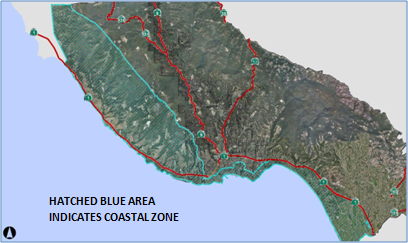What is the Coastal Zone?
The California Coastal Act of 1976 established a Coastal Zone along the State's Pacific Coast. In Santa Cruz County, this zone extends about five miles inland from the North Coast. From Natural Bridges to 41st Avenue in Capitola, it extends about 0.6 miles inland. From Capitola to the south County boundary, it extends to Highway One. For instructions on checking if your parcel is in the Coastal Zone, click here.

Within the Coastal Zone, development often requires approval of a Coastal Development permit. "Development" includes:
- Construction, reconstruction, size alteration, or demolition of a structure
- Grading, removing, placement, and extraction of any earth material
- Subdivision and minor land division
- Change in the density or intensity of land use
- Harvesting of major vegetation, except for agriculture and timber harvesting
Some smaller projects do not require approval of a Coastal Development permit. These include:
- Additions and demolitions to the existing structures and construction of accessory structures, such as garages, swimming pools, sheds, and fences, if they will be: Located outside the Appeal Jurisdiction and will contain less than 500 sq.ft. -or- Located within the Appeal Jurisdiction and will contain less than 250 sq.ft. or 10% of the total existing area in square feet (whichever is less).
- Landscaping outside of the blufftop and beach areas
- Replacement of wells, water tanks, and septic systems
- Repair and maintenance of roads, parks, industrial plants, and public utilities
- Replacement after a natural disaster; however, other code sections may require a development permit
Although a project may otherwise qualify for an exemption, a Coastal Development Permit may be required if:
- The structure is located on a beach or wetland
- The proposed improvement would be located within 50 feet of a coastal bluff or on the beach
In addition, certain projects within the urban areas of the County are eligible for exclusion from the requirement for a Coastal Zone Permit if they will be:
- Located in a "Residential Exclusion Zone" as shown on Official Coastal Zone maps - or -
- Not located within the Appeal Jurisdiction, a scenic corridor or a Special Community; and
- A principal permitted use in the applicable zone district.
These exclusion-eligible projects include:
- Construction, reconstruction, alteration, or demolition of up to 4 dwelling units
- Construction, etc, of any commercial structure containing less than 2,000 sq.ft.
- Commercial change of use
- Small agricultural development (See Section 13.20.073.)
- Lot Line Adjustments
- Grading less than 100 cubic yards
A Coastal exclusion can usually be issued along with a building permit. A small fee is charged. (For all exclusions, see Sections 13.20.070 et seq.
Seven areas along the coast have been set aside because of their unique scenic, historical, or beach-front character. They are:
- Bonny Doon Special Scenic Area
- Swanton Road Area
- Davenport Special Community
- Harbor Area Special Community
- East Cliff Village Tourist Area
- Seacliff Beach Area
- Rio Del Mar Esplanade
Development in these areas is subject to special design standards that will preserve their unique qualities. (See Santa Cruz County Code, Sections 13.20.140 through .147.)
Official County approvals on certain types of projects, and on projects in certain locations, may be appealed to the California Coastal Commission. These projects include development which:
- is located between the sea and the nearest through public road
- is located within 300 feet of a beach, high-tide line or coastal bluff top
- is located within 100 feet of any stream, estuary or wetland in the Coastal Zone
- proposes a use that is not a principal permitted use in the zone district
(These are shown on Coastal Zone Maps as "Appeal Jurisdictions".)
Coastal policies encourage the preservation of mature trees. In the urban or rural services lines, any tree that is 20" or more (approximately 5') in circumference, any sprout clump of five or more stems that is 3' or more in circumference, or any group of five or more trees on one parcel that are 3' or more incircumference may required a tree removal permit. Please contact Environmental Planning staff by email at EnvironmentalPlanningInfo@santacruzcountyca.gov or by self-scheduling an appointment with Environmental Planning staff. Trees that become so hazardous that they are a threat to life or property may be removed immediately, but you must notify Environmental Planning staff within 10 business days. (See Chapter 16.34.080 for specific regulations.)
If your project requires a Coastal Development Permit, you will need to apply for a Conditional Use Permit (CUP) or a Conditional Site Development Permit (CSP). (See Zoning Administrator Development Permits.)
Residents of property within 100 feet of the project site, as well as owners of property within 300 feet, will be notified of the public hearing.
Every Coastal development project must meet the design criteria and use standards of the particular zone district and Local Coastal Land Use Plan. It must also meet the Coastal Zone Design Criteria. These standards call for a harmonious appearance, minimum grading and tree-cutting, suitable landscaping, and the avoidance of ridgetops. (See County Code Section 13.20.130).
The Zoning Administrator's decision may be appealed by anyone who feels their interests have been affected. See the Planning Appeals page for more information.
If the project is located within the Appeal Jurisdiction, an approval may also be appealed to the California Coastal Commission, based on one of the five specific grounds regarding access, public view protection, land use compatibility, natural land forms, and erosion. These appear in Section 13.20.120 of the Santa Cruz County Code. Denials may not be appealed to the Coastal Commission.